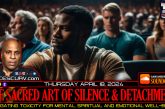Of course the world is an illusion! We see only a tiny part of the electromagnetic spectrum, which is divided into colours that exist only in our brains. We hear only a limited range of vibrations, onto which we impose meanings the vibrations do not themselves contain. We have no idea what dogs and bees find so interesting, and vice versa. We feel as soft or solid what is nearly all empty space, apart from a few fundamental particles in different arrangements. We can grasp directly only scales from around one millimetre to one kilometre. We think that the present is now, when we’re actually experiencing what happened half a second ago. Our personal, political, and ideological hang-ups and squabbles are blind to natural ecology and history – including the cells and DNA of our own bodies. Our heads are full of phantoms we impose on a world that is fundamentally indifferent to them. And yet that very indifference proves that the world is real!
On the basis that once the impossible is eliminated what remains must be the truth, the most convincing current hypothesis is that the world is made of information. This is abstract, spaceless, timeless, but can be consciously expressed only and necessarily in viewpoints of a physical world. This world emerges in a rational sequence of steps, its properties at each level depending on those of the level below. In a sense every emergent geometry and substance is illusory, yet it is also deeply real.
Dr Nicholas B. Taylor, Little Sandhurst
An illusion is a false sense-impression of something. This definition is a good starting point, since I will argue that the world exists, but that the sense-impressions we have of it are an illusion.
John Locke (1632-1704) held that objects have what he called primary and secondary qualities. Primary qualities are those he considered to be intrinsic to the object: its size, solidity, shape, number and position. Secondary qualities are not intrinsic but the result of “a power in the object” to create a sense-impression: to create colours, sounds, tastes, smells, feels in our minds.
We can update Locke. What do exist independently of our minds are objects consisting of molecules, particles, waves, forces. These are devoid of colour, sound or any of the other secondary qualities: the external world is dark, silent and colourless. Our sensory apparatus – our sense organs, sensory nervous system and sensory cortices – creates the illusion that the world is bright and colourful by transforming the raw data provided by our senses into colours, sounds, tastes, smells, sensations of hot and cold (and pain). These secondary qualities didn’t exist until they were invented by evolution. They evolved over time because those organisms that had the most informative senses had an evolutionary advantage.
Some idealists may disagree with these ideas and maintain, as George Berkeley (1685-1753) did, that just as colours, sounds and so on, are in the mind so physical objects are in the mind, as these objects just are their perceived properties. However, the existence even of our senses refutes Berkeley’s argument. Our senses (and those of other living creatures) evolved because they enabled us to compete, survive and procreate in a challenging environment that already existed. This process could not work in Berkeley’s world. A belief in evolution entails necessarily a belief in the existence of a mind-independent physical world. So the physical world exists, but we don’t see it as it really is, but according to an illusion created by our senses.
Michael Brake, Epsom, Surrey
In answering this question it is helpful to distinguish between ontology – what exists – and epistemology – how we know what we know. The question has an ontological part, ‘Is there something called the world?’, and an epistemological part, ‘Is my experience of this world false?’ The temptation is to conflate the two aspects of the question into either a naïve realist position – “The world exists and I experience it accurately” – or a naïve idealist “Everything is an illusion” position. But it seems perfectly possible to believe that an external world exists and at the same time believe that my experience of that world could be misinformative.
To briefly expand: I seem to have experiences of something. I can break this something down, first into the different senses – sight, sound, smell, touch and taste – through which I experience my body and other bodies that appear to be like mine. Further, I experience the unreasonable effectiveness of mathematics and science in making coherent, consistent, correspondent and pragmatic predictions about my experiences. This leads me to guess that something outside of me – call it ‘the world’ – really does exist. However, I cannot help but also note that I only appreciate this as a subjective being! However, no matter what the nature of the world actually is, I only experience it through my senses and therefore can only know the world in these terms. I simply have no idea whether this is a good representation of what the mind-independent world actually is. Furthermore, there will be other equally appropriate ways of experiencing the world using different senses of which I know nothing: to paraphrase Thomas Nagel, I can never know what the world is like from the perspective of a bat. Finally, I don’t even have a sure way of knowing whether others, who seem like me, experience the world in the same way. So, to summarise: No, that there is a world is probably not an illusion, but my experience of it could well be one.
Simon Kolstoe, University of Portsmouth
Is the world an illusion? I will first examine what is meant by ‘world’, and subsequently what is meant by ‘illusion’. People typically do not differentiate between ‘the world’ and its perception. This is called ‘naïve realism’. But in the domain of philosophy it is essential to distinguish between Immanuel Kant’s noumenon (mind-independent reality) and the phenomenon (the sensory appearance of the world). All that is perceived is the phenomenon; the noumenon is an hypothesis used to explain the existence of the phenomenon. The sum total of the perceptions of the world constitute a model of the world; all that one knows of the world is a model. The logical processes by which perceptions can be combined to create this model are based upon pattern identification of the sense-data. (I discuss these processes in detail in my book The Pattern Paradigm.)
So when one refers to ‘the world’ one is really referring to one’s model of the world. And while this model is only a model, it does enable one to interact effectively with the world (or model of the world) in order to meet one’s basic needs (and also, one’s not-so-basic needs). In this way the model of the world can be considered to be ‘real’ [Kant’s term for this is ‘empirically real’, Ed]. While everyone’s model of the world is different from everyone else’s, there is enough commonality for meaningful communication to take place.
An illusion is created through having a temporary fault with the sense organs resulting in faulty sense-data, or by utilising a pattern from the sense-data that is significantly less than optimum. Such an illusion would not allow for effective interaction with the world, and hence not enable one’s needs to be met. This is how it can be identified as an illusion and be distinguished from one’s useful model of the world. So there is a qualitative difference between a model of the world and an illusion that is sufficient to conclude that the world, or at least one’s model of the world, is not an illusion.
Bruce Robertson, Westmere, Auckland, N.Z.
The idea that although we may not be able to perceive reality directly we can at least make meaningful statements about it, was enough to spark David Hume’s doubts. Hume’s skepticism forged Hume’s fork. In this fork, Hume points out, first, that empiricism cannot deliver necessary truths: “Experience can teach us that something is the case but it cannot teach us that it must be the case.” According to Hume, reason is also ineffectual for delivering necessary truths about the world, as it only analyses definitions. Therefore, we cannot discover the way the world is through reason alone.
Then Kant proposes his Transcendental Idealism to prove that we can know ultimate reality through reason. He suggests our reason can transcend direct observation to get behind the phenomena and also understand the necessary conditions of experience. Kant argues that if we analyze our experience of an object, we can conclude for example that an object is always presented as occupying space. In fact, it is necessarily true, because we cannot imagine any object without that object occupying space. Also, all our experiences occur in time Kant also agrees with Hume that we cannot derive the necessity of causal relations from experience alone, but we can know its necessity through reason. (Therefore, Kant’s answer to Hume is that there is a pure knowledge which is independent of experience, which he calls synthetic a priori truth.) Kant showed that space, time and causality, the very texture of existence, are not fully mind-independent realities, as Newton supposed, nor are they mere figments of our imagination, as Hume claimed. Rather the entire phenomenal world is an intermediary between that which exists only in the mind, and reality as it exists in itself, independent of the mind.
Using Hume’s own metaphors, I would say, that the world is real and that its representation is not “a bastard of imagination, impregnated by experience…” but a legitimate child of Reason, and this child is delivered by our experience as an objective necessity.
Nella Leontieva, Sydney, N.S.W.
When considering whether the world is an illusion, the first question that comes to mind is what we mean by ‘world’. Is it the material part – the molecules and atoms that make up our universe? Or is it the part that makes up human existence – our sense of self, our emotions, thoughts, and feelings? Let’s examine both aspects.
Starting with the material world: consider first the fact that an atom is almost empty space. But the illusion gets deeper: quantum scientists are now strongly suggesting that all matter is made up of wavelike entities. If so, then our perception of reality is a major illusion.
Now let’s examine human existence, starting with what seems like an unshakeable notion – the idea of ‘I’. Yet in the late 6th century B.C.E., Siddhartha Gautama, the Buddha, argued that there is no ‘I’ and the self is an illusion. Thanks to neuroscience and MRI scans, some scientists are now suggesting that the Buddha may have been right, since they have been unable to find in our brain a single entity that controls our decisions and analyses our thoughts and emotions. In fact those who practise meditation would confirm that your desires, thoughts and emotions cannot be considered a fixed ‘you’ since they come and go, replaced by a new wave of them every few seconds.
What about free will? The debate around whether we have it may be endless, but many neuroscientists agree that our subconscious makes our decisions for us, while the conscious part of our brain creates a narrative for why we have made these decisions without us knowing the true reasons behind them; a fiction which has the purpose of explaining to the outside world our decisions and actions.
So is the world an illusion? It seems the answer is yes, since both the material and immaterial aspects of our life are deceiving us on a daily basis. But aren’t we all fond of tricks?
Alex Clackson, Birkenhead
Advaita Vedanta is a school of Hindu philosophy. Its idea of Maya is that perception is illusion. We humans are in temporal bondage, as our sensory perceptions and experiences of our body, and the consequential bodily attachments confound and obfuscate our true self. Self-realisation and liberation is possible by a method of Vedic self-enquiry requiring deep self contemplation through analytical negation – considering Neti Neti – that things are neither this, nor that; or, as Ramana Maharishi said, by repeatedly asking oneself the question ‘Who Am I?’ until the nature of Atma (our true self) is revealed and realized.
This self-scrutiny (or Atma Vichara) is not to be done merely at an intellectual level, but is meaningful and beneficial at the experiential level too. True, a discriminating mind and intellect (Buddhi) is essential for achieving self realisation. Upon attaining this self-realised state, where the boundary between one’s self and the universe disappears, one becomes an enlightened Jnani – one who has perceived the Para Brahman, the supreme reality of the universe, which is devoid of Maya.
Advaita Vedanta does not preach renunciation of the empirical world, but leads us to an understanding and acceptance of the reality of Maya along with its natural ability to bind us to the material world. This understanding and acceptance then naturally leads us to Vairagya (detachment). So, without denying the existence of the illusory Maya, it is essential for one to understand and experience, through self contemplation, the impermanence (Anitya) of our body, our mind, and the objects and fruits of our attachments on the one hand and the enduring permanence of our true self on the other.
Dr Ajay Kr. Sharma, Delhi University
The question of whether the world is an illusion resolves itself into this: Is there a world which we perceive, however inaccurately, which continues to exist when it is not perceived?
One possibility is that the world is an idea in the mind, ultimately, of God (the Bishop Berkeley theory). In this case, God would be the additional (and theologians would say ultimate) reality. However, if God is real, he/she is real in so different a sense of the word that we would be justified in arguing that the illusion created by God is actually the reality as we understand the concept.
Maybe I am the only reality and I created the world as an illusion (the solipsism theory). If I did so, I made a fine mess of it (consciously or unconsciously); and anyway, if I am real and nothing else is, what am I?
Maybe the world which I experience is an illusion I encounter in dreams (the Zhuangzi/butterfly theory). But my dreams change, whereas the illusion is consistent. This suggests that the dreams are the illusion.
Maybe I am the subject of an experiment in which other beings impose an illusion on my awareness (the Matrix theory). This is an untestable theory, but it seems improbable that such an experiment could be carried out without something going wrong and either ending the experiment or alerting me to it. The one thing that reality and illusion have in common is that something always breaks down!
So, all theories that the world is an illusion carry difficulties with them. We cannot prove that the world is real; but, applying Ockham’s razor, we can show that this is the theory with the fewest (if any) difficulties.
Martin Jenkins, London
The following argument bears some similarity to arguments of Zeno of Elea, but is not the same. It concludes that the physical world cannot be real.
If the physical world exists, then, within that world, there are many distances, all of which are finite. Now, how many times can a finite length be subdivided into smaller lengths? Either an unlimited number of times, or a limited number of times. But dividing it an infinite number of times has a strange result. Assuming an infinite number of subdivisions means that each of the subdivisions must have zero length. If the length of the divisions were larger than zero, the original finite length would only have been divided a finite number of times. But, if the divisions each have zero length, this means that if all the divisions are added together, the overall length is zero! So something’s wrong. The idea that length can be infinitely subdivided can’t be right.
This leaves the option that the length can only be subdivided a finite number of times. That would mean that the smallest possible divisions would still have some length, however small. But, this also causes a problem, because something can only have some length if there are other points between the two ends of that length. If there are, then it could always be further subdivided. So a finite number of divisions could always be further divided. Therefore, the number of possible divisions cannot be limited and must be unlimited, or infinite, after all.
So first we saw that finite lengths cannot be divided an infinite number of times; and then we saw that they must be infinitely divisible! Therefore, the very idea of finite lengths appears to contradict itself. This means it cannot be correct. So finite lengths cannot be real – which means the physical world cannot be real either, since it is composed of numerous features which have limited sizes. How can a planet with a diameter of roughly 8,000 miles exist, if finite distances are impossible?
Peter Spurrier, Halstead, Essex
The idea that the world is an illusion tells us nothing. A word, to mean something, must also not mean something else. We understand illusion because we understand reality. To call everything an illusion would destroy the very concept of reality needed to establish what an illusion was in the first place. Therefore, it is better to ask, what is and is not real?
For people with common sense, the world is about as much an illusion as there is illusion in the sting of a bellyflop. I remember my first: it was P.E., and despite my stiff upper lip, the reality that was radiating pink heat and pain from off my belly was screaming its testimony for all to see. These two hands of mine are also self-evidently real. So now we have three real things. If anyone disagrees, then I would like to offer them, in friendly and gentlemanly fashion, my hospitality at hearth and home, and then imprint on their belly a burning bright hand print. Extreme scepticism usually has a shelf-life that is inverse to suffering.
Many might take issue with my brute fact approach. That’s OK, if we agree that all axioms are undemonstrable. Axioms are never deduced, they are assumed without proof because of the problem of infinite regress. To ask justification for an axiom would force us back to another proposition, and since that would also require justification, we would be forced to go on ad infinitum. Where we take our leave from that infinite train is where we reveal our biases. That is why I stand with Nietzsche concerning first things – that every great philosophy consists of the confession of its originator, and a species of involuntary and unconscious autobiography. But unlike Nietzsche, I believe that God is not dead. And that has made all the difference. Since my God is the author of reality and history, I have no qualms about my belief being a confession and an autobiography. How could it be otherwise? So for all who are wondering what is really real… well, have I got good news for you!
Eneree Gundalai, Hannover, Germany














